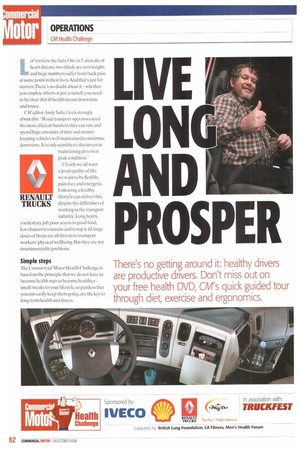LIVE
Page 62

Page 63

If you've noticed an error in this article please click here to report it so we can fix it.
LONG
AND
PROSPER
There's no getting around it: healthy drivers are productive drivers. Don't miss out on your free health DVD, CM's quick guided tour
through diet, exercise and ergonomics.
review the facts. One in 5 men die of heart disease; two thirds arc overweight; and huge numbers suffer from back pain
at some point in their lives. And that's just for starters.There's no doubt about it —whether you employ others or just yourself, you need to be clear that ill health means down time and losses. CM editor Andy Salter feels strongly about this: "Road transport operators need the most efficient business they can run, and spend huge amounts of time and money keeping vehicles well maintained to minimise down time. It is only sensible to also invest in
maintaining drivers in peak condition." Clearly we all want a good quality of life: we want to be flexible. pain-free and energetic. Following a healthy lifestyle can deliver this, despite the difficulties of working in the transport industry. Long hours, a sedentary job, poor access to good food, few chances to exercise and to top it all, large doses of stress are all threats to transport workers physical wellbeing. But they are not insurmountable problems,
Simple steps
rlbe Commercial Motor Health Challenge is based on the principle that we do not have to become health nuts to become healthier— small tweaks to your lifestyle, so painless that you can easily keep them going, are the key to long-term health and fitness.
One of the most important factors from a driver's perspective is a good choice of cab.
The Commercial Motor DVD was produced in collaboration with Renault, which provided a Premium cab to demonstrate the benefits of sound ergonomics to the driver and ultimately his employer.
Being able to adjust the seat, get the rake of the steering wheel right and reach the pedals without overreaching or bunching the leg muscles are all essential to drivers' long-term health. People can develop muscle pain and cramping which causes problems such as adhesive capsulitis (frozen shoulder). tense necks and lower back pain within hours —all of which can stop someone working.
Breaking bad habits
It is vital that the cab provides sufficient flexibility to get the driver comfortable and also that he knows how to make the necessary adjustments. People often choose positions that feel comfortable to them because they are used to being in an unhealthy posture —stomach slack,shoulders rounded, chin forward— and adjust their seat accordingly.
Cab ergonomics are particularly important because in sitting still and driving for long periods we are asking the body to do something fundamentally unnatural. Humans evolved over millions of years to hunt and gather; activity is essential to our well-being. When we sit still we not only slow our metabolism and blood circulation but put our muscles into static, shortened positions,causing pain,discomfort and postural problems.
Just as you should take professional advice before setting yourself up at a computer monitor, drivers should get professional advice about how to set up their seats and mirrors. Remember, if a driver suffers a work-related injury, his or her employer is responsible.
The CM DVD talks through the importance of diet, regular exercise and stretching (with physiotherapist Sam Bowden showing you the moves), and the necessity of setting your driver up with a cab he can live and work in without compromising his well-being. Bruce Allison, sales and marketing director of Rena ult Trucks, says: "We are fully supportive of Comi»ercial Motor's Health
Challenge. Renault Trucks' vehicle design philosophy puts the driving environment at the top of its list of priorities.While we do everything we possibly can to take account of ergonomics, in-cab noise, drivi ng position and overall safety. it is still the drivers' responsibility to control the maintenance of their own bodies. However good the vehicle, you're going to be a better driver if you are fit for the job."
If you want more information or support on weight loss, heart disease, diabetes, mental illness, stress. exercise and stretching, or any of the other topics we have covered during the CM Health Challenge campaign. please see our archive at www.commercial-motor.com. All ideas need to be communicated— including good health. Send for your (TM/Renault DVD today and raise the level of fitness in your company and in your cab. •
Checking the basics
All drivers should:
• eat breakfast. Low blood-sugar levels dampen your ability to concentrate.
• be properly hydrated. Dehydration causes fatigue and headaches.
• have their seats adjusted so the pedals can be reached comfortably and without cramping or overreaching.
• adjust their vehicle's mirrors to provide the maximum view with the minir—um of head movement. You shouldn't need to lean or stretch. The correct sequence for adjusting the driver's seat is as follows: 1 • Seat height 2. Seat forwards/backwards 3. Seat cushion tilt 4. Back rest— check it is in contact up to the shoulder 5. Lumbar support adjustment 6. Steering wheel adjustment 7. Head restraint adjustment
If you do these in the wrong order, you will undo the good work of one aspect as you fix another.


























































































































































































